The approaches, tools, and methodologies in this section argue for a more nuanced and sophisticated understanding of corruption in order to better describe and explain its various modalities and invite practitioners to take action.
This set of papers aims to make a contribution toward the wider agenda of shifting the conversation from an existing paradigm that has stalled toward a more focused and actionable framework for both understanding and tackling corruption. We want to interrogate issues in order to identify the key practical changes needed to help make progress on the agenda of rethinking corruption. The ultimate aim is to translate that understanding into more effective anti-corruption policy design and practice.
![]()
Janine Wedel’s Mapping Method sets out a guide for charting corruption, offering a practical way to identify the key players in corruption or influence networks in order to reveal their roles and interconnections in an increasingly fluid framework of power and resources.
![]()
Paul Heywood and Mark Pyman’s paper on Strategy, Scale and Substance sets the stage for developing more effective anti-corruption strategies, as further explored in their Sector Focus and Reformulation Approach (SFRA). In line with the growing acceptance that context matters, and that we need to understand much better the specific modalities of corruption in given settings, they argue that a crucial step is to better understand the real objectives of reform measures.
![]()
Heather Marquette and Caryn Peiffer lay the groundwork for analyzing interventions in their Corruption Functionality Framework. Their four-step approach helps those designing anti-corruption interventions to understand why ‘everyday’ corruption appears to provide solutions to problems that formal structures and systems fail to address.
The issues tackled in the papers are complex, messy, contested and – all too often – thoroughly intractable. Not only are there scholarly disagreements, but there is often a more general disjuncture between academic analysis and the policy world. In fact, nearly all the key questions in relation to corruption (its definition, nature, causes, extent, location, impact, and susceptibility to reform) are contested. However, the insights and guidance presented in the papers offer practical responses to the broad failure of approaches to combating corruption that have been developed over the last 25 years.




